Promoting Health Literacy: HIV Risk Reduction for Key Populations
VerifiedAdded on 2023/06/12
|10
|2495
|75
Essay
AI Summary
This essay explores the role of community nurses in leveraging health education to enhance health literacy and mitigate HIV risks among key populations, including men who have sex with men, people who inject drugs, incarcerated individuals, sex workers, and transgender people. It begins by defining health education and health literacy, emphasizing their importance in empowering individuals to make informed health decisions. The essay then identifies the specific risk factors faced by these key populations, such as needle sharing among drug users and unprotected sex among sex workers. It details various health education strategies that community nurses can employ, including enforcing healthy public policies, community mobilization, strengthening community action, developing personal skills, re-orienting health services, raising public awareness, integrating HIV information into rehabilitation programs, and addressing community misconceptions about HIV/AIDS. The essay concludes that by implementing these strategies, community nurses can effectively promote health literacy, reduce HIV transmission, and improve the overall health outcomes of vulnerable populations.
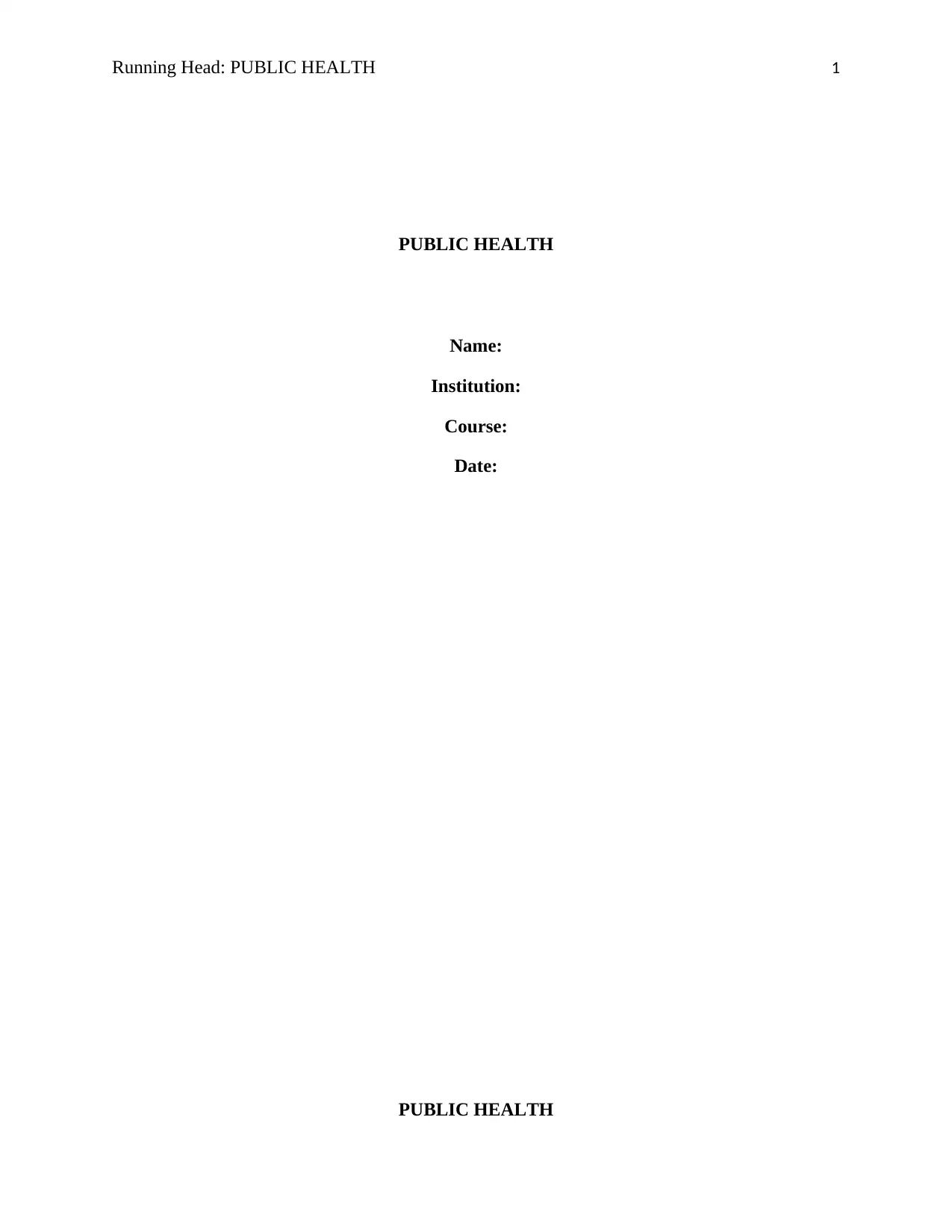
Running Head: PUBLIC HEALTH 1
PUBLIC HEALTH
Name:
Institution:
Course:
Date:
PUBLIC HEALTH
PUBLIC HEALTH
Name:
Institution:
Course:
Date:
PUBLIC HEALTH
Secure Best Marks with AI Grader
Need help grading? Try our AI Grader for instant feedback on your assignments.
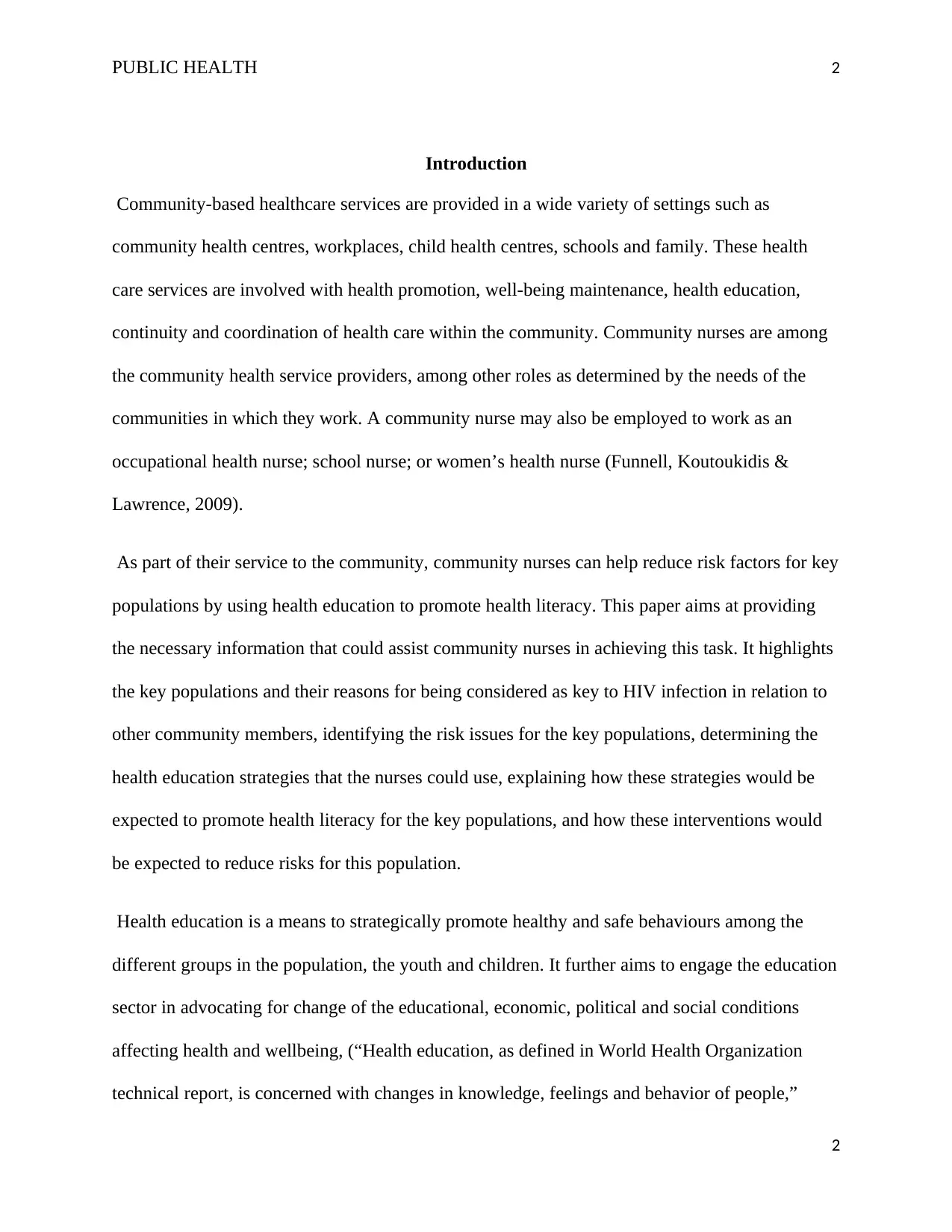
PUBLIC HEALTH 2
Introduction
Community-based healthcare services are provided in a wide variety of settings such as
community health centres, workplaces, child health centres, schools and family. These health
care services are involved with health promotion, well-being maintenance, health education,
continuity and coordination of health care within the community. Community nurses are among
the community health service providers, among other roles as determined by the needs of the
communities in which they work. A community nurse may also be employed to work as an
occupational health nurse; school nurse; or women’s health nurse (Funnell, Koutoukidis &
Lawrence, 2009).
As part of their service to the community, community nurses can help reduce risk factors for key
populations by using health education to promote health literacy. This paper aims at providing
the necessary information that could assist community nurses in achieving this task. It highlights
the key populations and their reasons for being considered as key to HIV infection in relation to
other community members, identifying the risk issues for the key populations, determining the
health education strategies that the nurses could use, explaining how these strategies would be
expected to promote health literacy for the key populations, and how these interventions would
be expected to reduce risks for this population.
Health education is a means to strategically promote healthy and safe behaviours among the
different groups in the population, the youth and children. It further aims to engage the education
sector in advocating for change of the educational, economic, political and social conditions
affecting health and wellbeing, (“Health education, as defined in World Health Organization
technical report, is concerned with changes in knowledge, feelings and behavior of people,”
2
Introduction
Community-based healthcare services are provided in a wide variety of settings such as
community health centres, workplaces, child health centres, schools and family. These health
care services are involved with health promotion, well-being maintenance, health education,
continuity and coordination of health care within the community. Community nurses are among
the community health service providers, among other roles as determined by the needs of the
communities in which they work. A community nurse may also be employed to work as an
occupational health nurse; school nurse; or women’s health nurse (Funnell, Koutoukidis &
Lawrence, 2009).
As part of their service to the community, community nurses can help reduce risk factors for key
populations by using health education to promote health literacy. This paper aims at providing
the necessary information that could assist community nurses in achieving this task. It highlights
the key populations and their reasons for being considered as key to HIV infection in relation to
other community members, identifying the risk issues for the key populations, determining the
health education strategies that the nurses could use, explaining how these strategies would be
expected to promote health literacy for the key populations, and how these interventions would
be expected to reduce risks for this population.
Health education is a means to strategically promote healthy and safe behaviours among the
different groups in the population, the youth and children. It further aims to engage the education
sector in advocating for change of the educational, economic, political and social conditions
affecting health and wellbeing, (“Health education, as defined in World Health Organization
technical report, is concerned with changes in knowledge, feelings and behavior of people,”
2
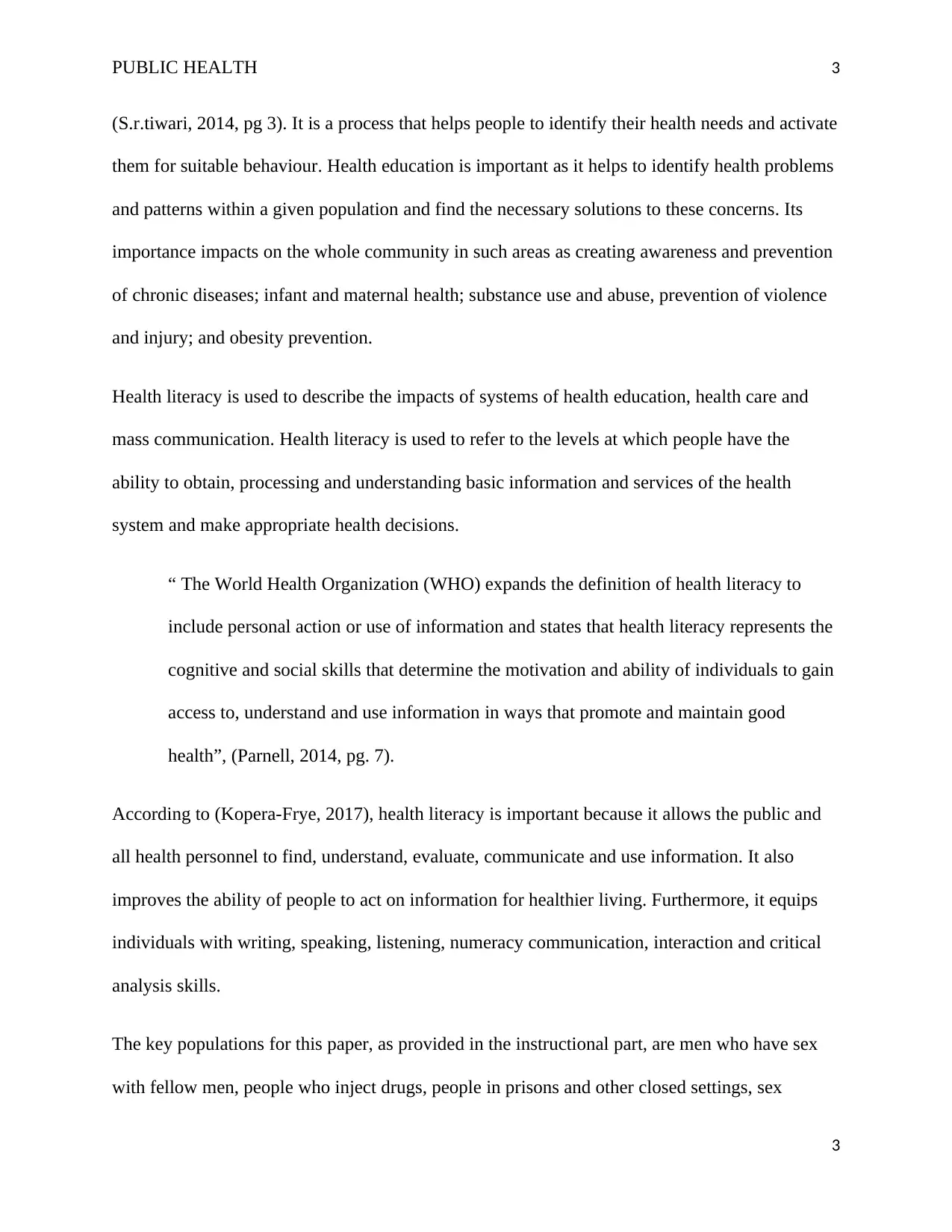
PUBLIC HEALTH 3
(S.r.tiwari, 2014, pg 3). It is a process that helps people to identify their health needs and activate
them for suitable behaviour. Health education is important as it helps to identify health problems
and patterns within a given population and find the necessary solutions to these concerns. Its
importance impacts on the whole community in such areas as creating awareness and prevention
of chronic diseases; infant and maternal health; substance use and abuse, prevention of violence
and injury; and obesity prevention.
Health literacy is used to describe the impacts of systems of health education, health care and
mass communication. Health literacy is used to refer to the levels at which people have the
ability to obtain, processing and understanding basic information and services of the health
system and make appropriate health decisions.
“ The World Health Organization (WHO) expands the definition of health literacy to
include personal action or use of information and states that health literacy represents the
cognitive and social skills that determine the motivation and ability of individuals to gain
access to, understand and use information in ways that promote and maintain good
health”, (Parnell, 2014, pg. 7).
According to (Kopera-Frye, 2017), health literacy is important because it allows the public and
all health personnel to find, understand, evaluate, communicate and use information. It also
improves the ability of people to act on information for healthier living. Furthermore, it equips
individuals with writing, speaking, listening, numeracy communication, interaction and critical
analysis skills.
The key populations for this paper, as provided in the instructional part, are men who have sex
with fellow men, people who inject drugs, people in prisons and other closed settings, sex
3
(S.r.tiwari, 2014, pg 3). It is a process that helps people to identify their health needs and activate
them for suitable behaviour. Health education is important as it helps to identify health problems
and patterns within a given population and find the necessary solutions to these concerns. Its
importance impacts on the whole community in such areas as creating awareness and prevention
of chronic diseases; infant and maternal health; substance use and abuse, prevention of violence
and injury; and obesity prevention.
Health literacy is used to describe the impacts of systems of health education, health care and
mass communication. Health literacy is used to refer to the levels at which people have the
ability to obtain, processing and understanding basic information and services of the health
system and make appropriate health decisions.
“ The World Health Organization (WHO) expands the definition of health literacy to
include personal action or use of information and states that health literacy represents the
cognitive and social skills that determine the motivation and ability of individuals to gain
access to, understand and use information in ways that promote and maintain good
health”, (Parnell, 2014, pg. 7).
According to (Kopera-Frye, 2017), health literacy is important because it allows the public and
all health personnel to find, understand, evaluate, communicate and use information. It also
improves the ability of people to act on information for healthier living. Furthermore, it equips
individuals with writing, speaking, listening, numeracy communication, interaction and critical
analysis skills.
The key populations for this paper, as provided in the instructional part, are men who have sex
with fellow men, people who inject drugs, people in prisons and other closed settings, sex
3
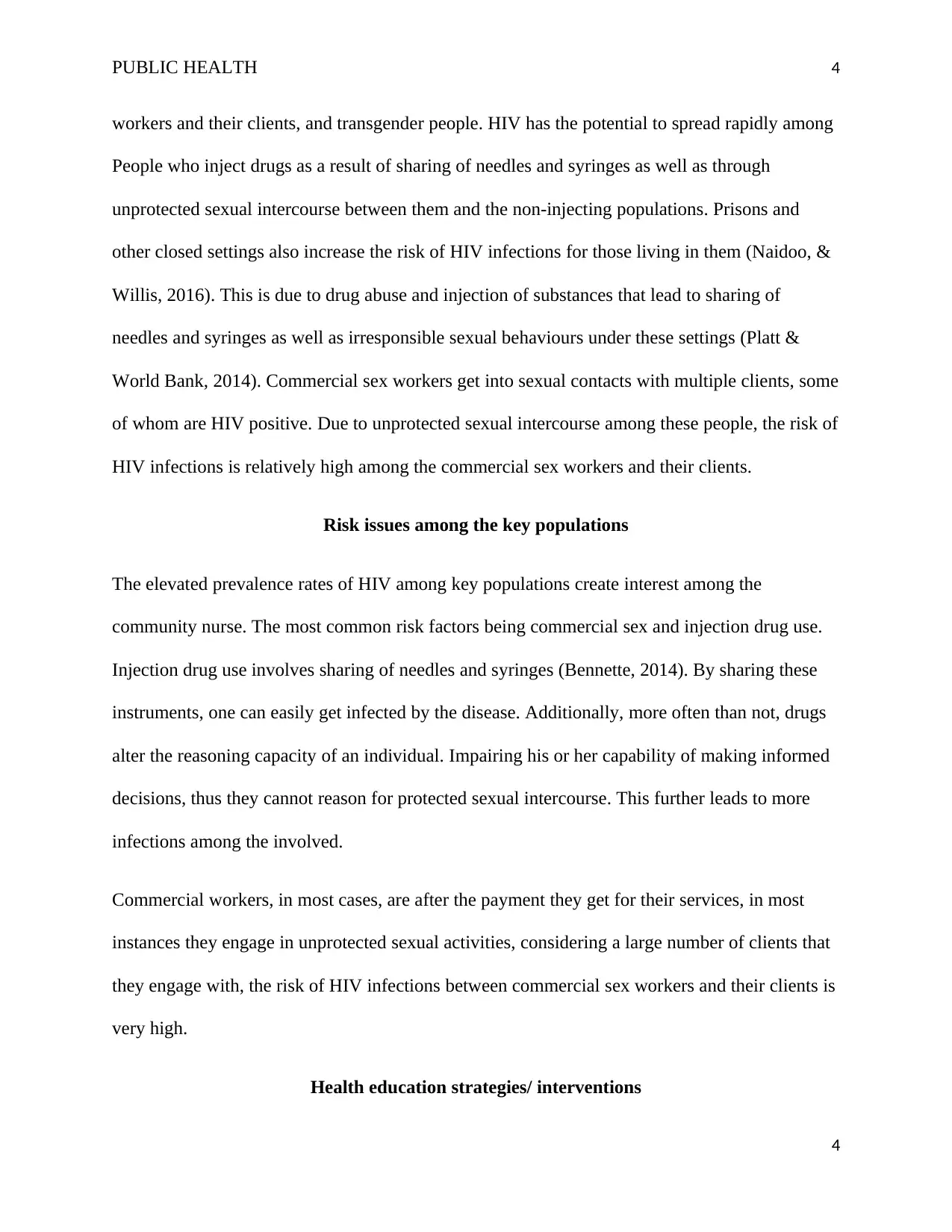
PUBLIC HEALTH 4
workers and their clients, and transgender people. HIV has the potential to spread rapidly among
People who inject drugs as a result of sharing of needles and syringes as well as through
unprotected sexual intercourse between them and the non-injecting populations. Prisons and
other closed settings also increase the risk of HIV infections for those living in them (Naidoo, &
Willis, 2016). This is due to drug abuse and injection of substances that lead to sharing of
needles and syringes as well as irresponsible sexual behaviours under these settings (Platt &
World Bank, 2014). Commercial sex workers get into sexual contacts with multiple clients, some
of whom are HIV positive. Due to unprotected sexual intercourse among these people, the risk of
HIV infections is relatively high among the commercial sex workers and their clients.
Risk issues among the key populations
The elevated prevalence rates of HIV among key populations create interest among the
community nurse. The most common risk factors being commercial sex and injection drug use.
Injection drug use involves sharing of needles and syringes (Bennette, 2014). By sharing these
instruments, one can easily get infected by the disease. Additionally, more often than not, drugs
alter the reasoning capacity of an individual. Impairing his or her capability of making informed
decisions, thus they cannot reason for protected sexual intercourse. This further leads to more
infections among the involved.
Commercial workers, in most cases, are after the payment they get for their services, in most
instances they engage in unprotected sexual activities, considering a large number of clients that
they engage with, the risk of HIV infections between commercial sex workers and their clients is
very high.
Health education strategies/ interventions
4
workers and their clients, and transgender people. HIV has the potential to spread rapidly among
People who inject drugs as a result of sharing of needles and syringes as well as through
unprotected sexual intercourse between them and the non-injecting populations. Prisons and
other closed settings also increase the risk of HIV infections for those living in them (Naidoo, &
Willis, 2016). This is due to drug abuse and injection of substances that lead to sharing of
needles and syringes as well as irresponsible sexual behaviours under these settings (Platt &
World Bank, 2014). Commercial sex workers get into sexual contacts with multiple clients, some
of whom are HIV positive. Due to unprotected sexual intercourse among these people, the risk of
HIV infections is relatively high among the commercial sex workers and their clients.
Risk issues among the key populations
The elevated prevalence rates of HIV among key populations create interest among the
community nurse. The most common risk factors being commercial sex and injection drug use.
Injection drug use involves sharing of needles and syringes (Bennette, 2014). By sharing these
instruments, one can easily get infected by the disease. Additionally, more often than not, drugs
alter the reasoning capacity of an individual. Impairing his or her capability of making informed
decisions, thus they cannot reason for protected sexual intercourse. This further leads to more
infections among the involved.
Commercial workers, in most cases, are after the payment they get for their services, in most
instances they engage in unprotected sexual activities, considering a large number of clients that
they engage with, the risk of HIV infections between commercial sex workers and their clients is
very high.
Health education strategies/ interventions
4
Secure Best Marks with AI Grader
Need help grading? Try our AI Grader for instant feedback on your assignments.
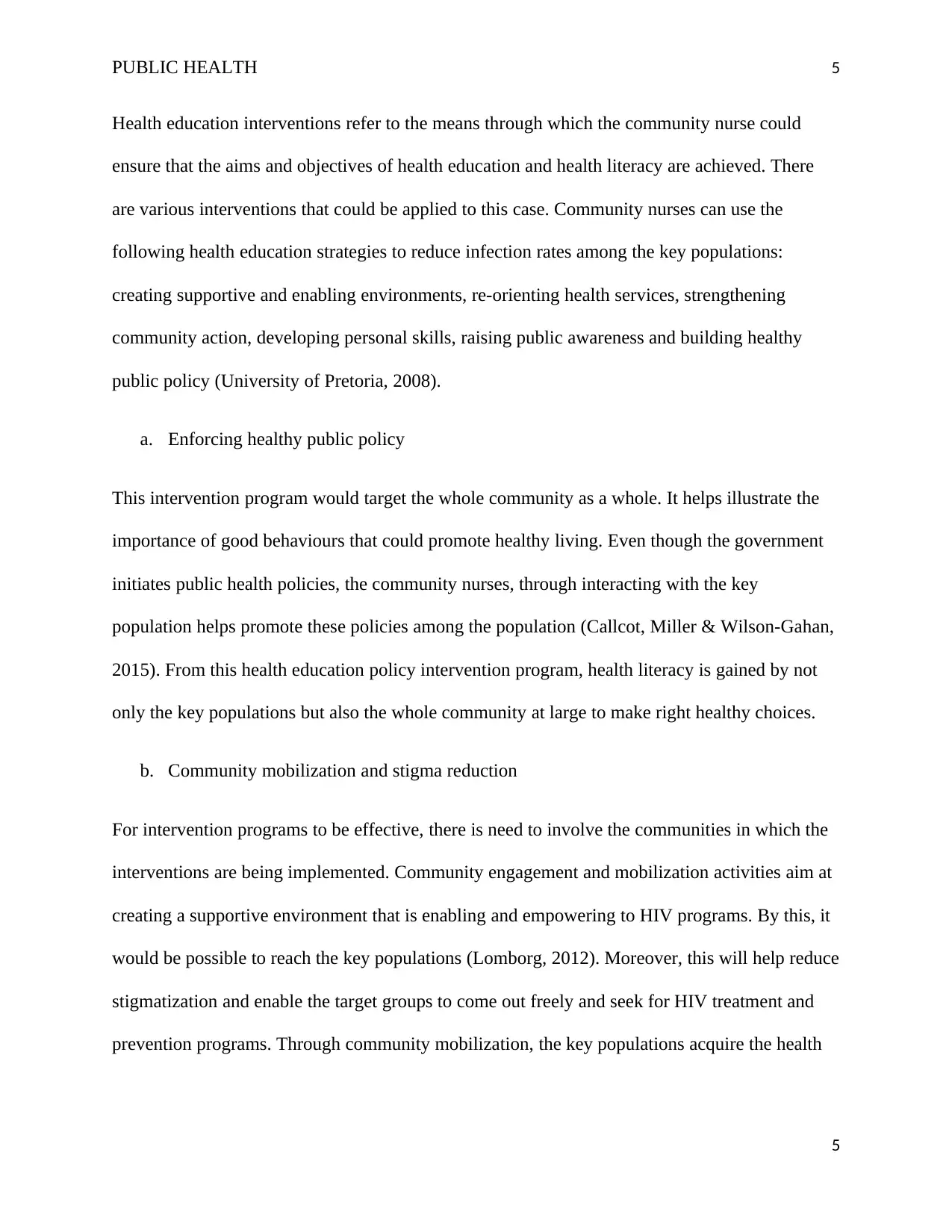
PUBLIC HEALTH 5
Health education interventions refer to the means through which the community nurse could
ensure that the aims and objectives of health education and health literacy are achieved. There
are various interventions that could be applied to this case. Community nurses can use the
following health education strategies to reduce infection rates among the key populations:
creating supportive and enabling environments, re-orienting health services, strengthening
community action, developing personal skills, raising public awareness and building healthy
public policy (University of Pretoria, 2008).
a. Enforcing healthy public policy
This intervention program would target the whole community as a whole. It helps illustrate the
importance of good behaviours that could promote healthy living. Even though the government
initiates public health policies, the community nurses, through interacting with the key
population helps promote these policies among the population (Callcot, Miller & Wilson-Gahan,
2015). From this health education policy intervention program, health literacy is gained by not
only the key populations but also the whole community at large to make right healthy choices.
b. Community mobilization and stigma reduction
For intervention programs to be effective, there is need to involve the communities in which the
interventions are being implemented. Community engagement and mobilization activities aim at
creating a supportive environment that is enabling and empowering to HIV programs. By this, it
would be possible to reach the key populations (Lomborg, 2012). Moreover, this will help reduce
stigmatization and enable the target groups to come out freely and seek for HIV treatment and
prevention programs. Through community mobilization, the key populations acquire the health
5
Health education interventions refer to the means through which the community nurse could
ensure that the aims and objectives of health education and health literacy are achieved. There
are various interventions that could be applied to this case. Community nurses can use the
following health education strategies to reduce infection rates among the key populations:
creating supportive and enabling environments, re-orienting health services, strengthening
community action, developing personal skills, raising public awareness and building healthy
public policy (University of Pretoria, 2008).
a. Enforcing healthy public policy
This intervention program would target the whole community as a whole. It helps illustrate the
importance of good behaviours that could promote healthy living. Even though the government
initiates public health policies, the community nurses, through interacting with the key
population helps promote these policies among the population (Callcot, Miller & Wilson-Gahan,
2015). From this health education policy intervention program, health literacy is gained by not
only the key populations but also the whole community at large to make right healthy choices.
b. Community mobilization and stigma reduction
For intervention programs to be effective, there is need to involve the communities in which the
interventions are being implemented. Community engagement and mobilization activities aim at
creating a supportive environment that is enabling and empowering to HIV programs. By this, it
would be possible to reach the key populations (Lomborg, 2012). Moreover, this will help reduce
stigmatization and enable the target groups to come out freely and seek for HIV treatment and
prevention programs. Through community mobilization, the key populations acquire the health
5
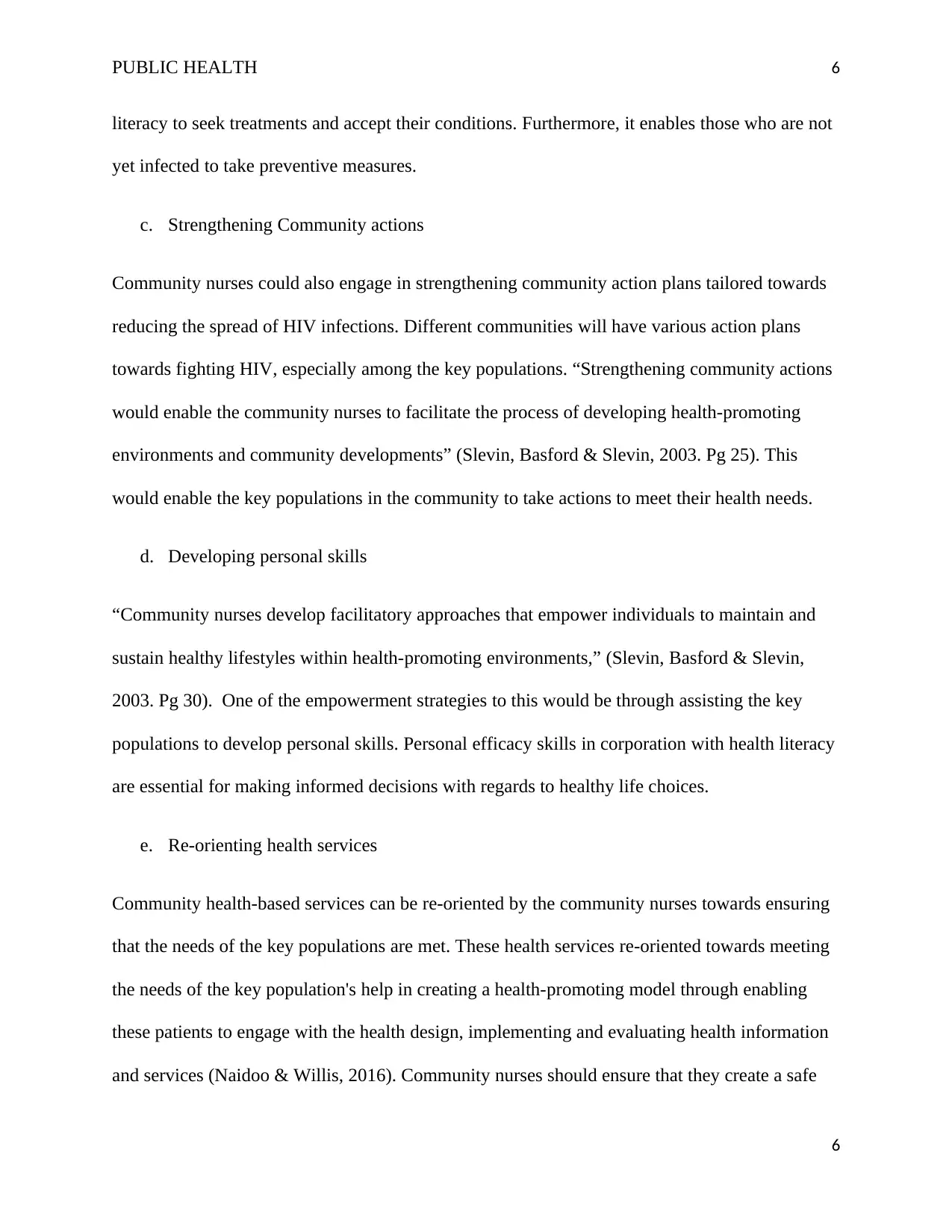
PUBLIC HEALTH 6
literacy to seek treatments and accept their conditions. Furthermore, it enables those who are not
yet infected to take preventive measures.
c. Strengthening Community actions
Community nurses could also engage in strengthening community action plans tailored towards
reducing the spread of HIV infections. Different communities will have various action plans
towards fighting HIV, especially among the key populations. “Strengthening community actions
would enable the community nurses to facilitate the process of developing health-promoting
environments and community developments” (Slevin, Basford & Slevin, 2003. Pg 25). This
would enable the key populations in the community to take actions to meet their health needs.
d. Developing personal skills
“Community nurses develop facilitatory approaches that empower individuals to maintain and
sustain healthy lifestyles within health-promoting environments,” (Slevin, Basford & Slevin,
2003. Pg 30). One of the empowerment strategies to this would be through assisting the key
populations to develop personal skills. Personal efficacy skills in corporation with health literacy
are essential for making informed decisions with regards to healthy life choices.
e. Re-orienting health services
Community health-based services can be re-oriented by the community nurses towards ensuring
that the needs of the key populations are met. These health services re-oriented towards meeting
the needs of the key population's help in creating a health-promoting model through enabling
these patients to engage with the health design, implementing and evaluating health information
and services (Naidoo & Willis, 2016). Community nurses should ensure that they create a safe
6
literacy to seek treatments and accept their conditions. Furthermore, it enables those who are not
yet infected to take preventive measures.
c. Strengthening Community actions
Community nurses could also engage in strengthening community action plans tailored towards
reducing the spread of HIV infections. Different communities will have various action plans
towards fighting HIV, especially among the key populations. “Strengthening community actions
would enable the community nurses to facilitate the process of developing health-promoting
environments and community developments” (Slevin, Basford & Slevin, 2003. Pg 25). This
would enable the key populations in the community to take actions to meet their health needs.
d. Developing personal skills
“Community nurses develop facilitatory approaches that empower individuals to maintain and
sustain healthy lifestyles within health-promoting environments,” (Slevin, Basford & Slevin,
2003. Pg 30). One of the empowerment strategies to this would be through assisting the key
populations to develop personal skills. Personal efficacy skills in corporation with health literacy
are essential for making informed decisions with regards to healthy life choices.
e. Re-orienting health services
Community health-based services can be re-oriented by the community nurses towards ensuring
that the needs of the key populations are met. These health services re-oriented towards meeting
the needs of the key population's help in creating a health-promoting model through enabling
these patients to engage with the health design, implementing and evaluating health information
and services (Naidoo & Willis, 2016). Community nurses should ensure that they create a safe
6
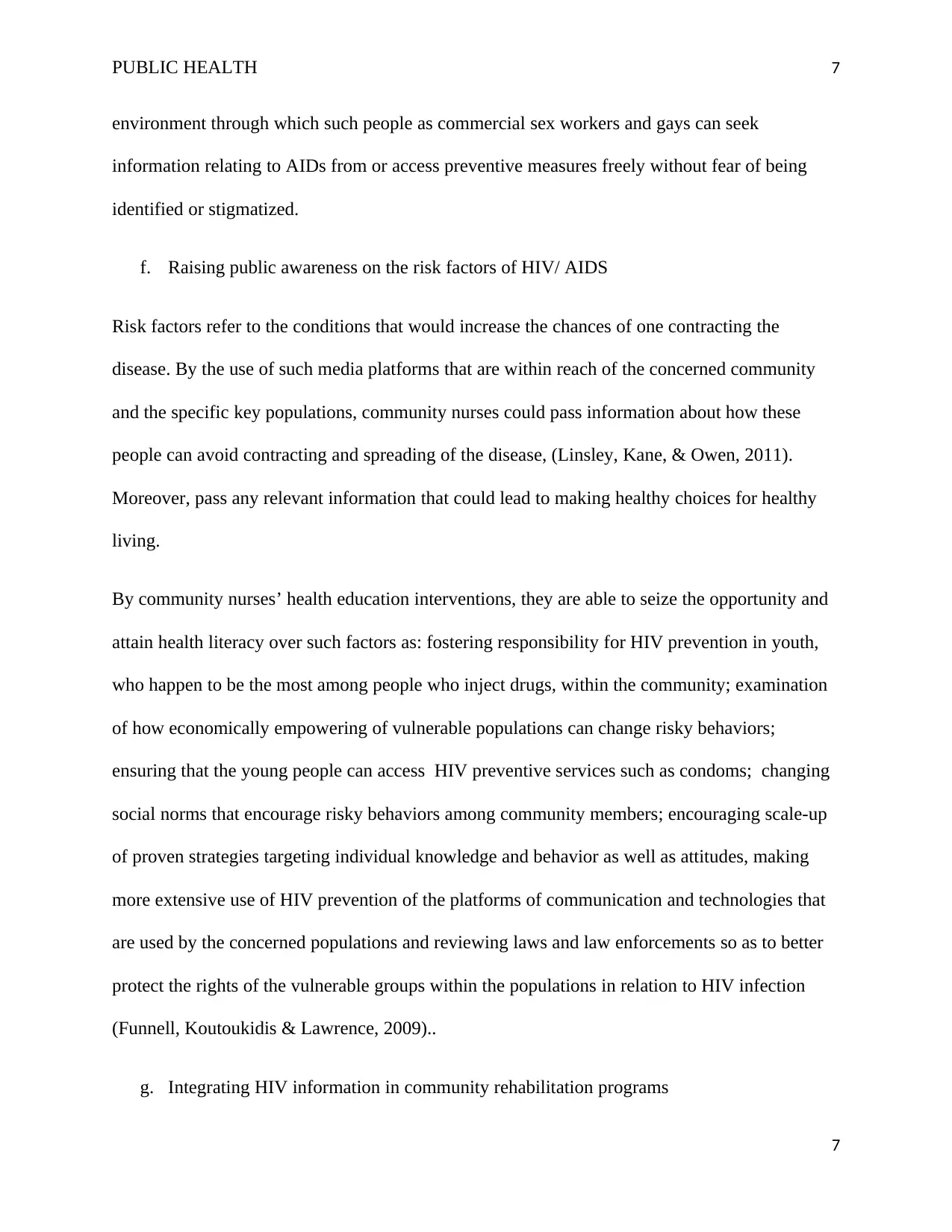
PUBLIC HEALTH 7
environment through which such people as commercial sex workers and gays can seek
information relating to AIDs from or access preventive measures freely without fear of being
identified or stigmatized.
f. Raising public awareness on the risk factors of HIV/ AIDS
Risk factors refer to the conditions that would increase the chances of one contracting the
disease. By the use of such media platforms that are within reach of the concerned community
and the specific key populations, community nurses could pass information about how these
people can avoid contracting and spreading of the disease, (Linsley, Kane, & Owen, 2011).
Moreover, pass any relevant information that could lead to making healthy choices for healthy
living.
By community nurses’ health education interventions, they are able to seize the opportunity and
attain health literacy over such factors as: fostering responsibility for HIV prevention in youth,
who happen to be the most among people who inject drugs, within the community; examination
of how economically empowering of vulnerable populations can change risky behaviors;
ensuring that the young people can access HIV preventive services such as condoms; changing
social norms that encourage risky behaviors among community members; encouraging scale-up
of proven strategies targeting individual knowledge and behavior as well as attitudes, making
more extensive use of HIV prevention of the platforms of communication and technologies that
are used by the concerned populations and reviewing laws and law enforcements so as to better
protect the rights of the vulnerable groups within the populations in relation to HIV infection
(Funnell, Koutoukidis & Lawrence, 2009)..
g. Integrating HIV information in community rehabilitation programs
7
environment through which such people as commercial sex workers and gays can seek
information relating to AIDs from or access preventive measures freely without fear of being
identified or stigmatized.
f. Raising public awareness on the risk factors of HIV/ AIDS
Risk factors refer to the conditions that would increase the chances of one contracting the
disease. By the use of such media platforms that are within reach of the concerned community
and the specific key populations, community nurses could pass information about how these
people can avoid contracting and spreading of the disease, (Linsley, Kane, & Owen, 2011).
Moreover, pass any relevant information that could lead to making healthy choices for healthy
living.
By community nurses’ health education interventions, they are able to seize the opportunity and
attain health literacy over such factors as: fostering responsibility for HIV prevention in youth,
who happen to be the most among people who inject drugs, within the community; examination
of how economically empowering of vulnerable populations can change risky behaviors;
ensuring that the young people can access HIV preventive services such as condoms; changing
social norms that encourage risky behaviors among community members; encouraging scale-up
of proven strategies targeting individual knowledge and behavior as well as attitudes, making
more extensive use of HIV prevention of the platforms of communication and technologies that
are used by the concerned populations and reviewing laws and law enforcements so as to better
protect the rights of the vulnerable groups within the populations in relation to HIV infection
(Funnell, Koutoukidis & Lawrence, 2009)..
g. Integrating HIV information in community rehabilitation programs
7
Paraphrase This Document
Need a fresh take? Get an instant paraphrase of this document with our AI Paraphraser
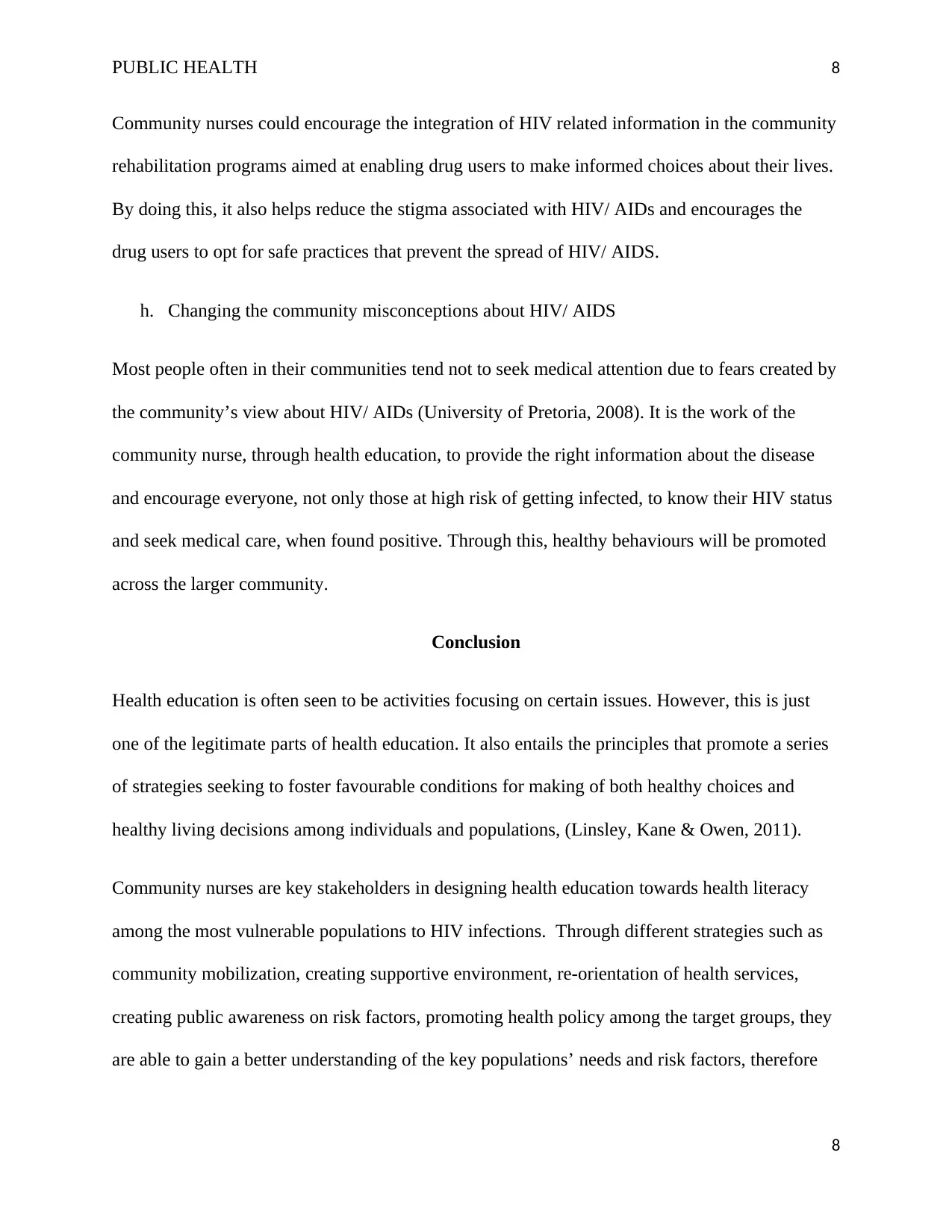
PUBLIC HEALTH 8
Community nurses could encourage the integration of HIV related information in the community
rehabilitation programs aimed at enabling drug users to make informed choices about their lives.
By doing this, it also helps reduce the stigma associated with HIV/ AIDs and encourages the
drug users to opt for safe practices that prevent the spread of HIV/ AIDS.
h. Changing the community misconceptions about HIV/ AIDS
Most people often in their communities tend not to seek medical attention due to fears created by
the community’s view about HIV/ AIDs (University of Pretoria, 2008). It is the work of the
community nurse, through health education, to provide the right information about the disease
and encourage everyone, not only those at high risk of getting infected, to know their HIV status
and seek medical care, when found positive. Through this, healthy behaviours will be promoted
across the larger community.
Conclusion
Health education is often seen to be activities focusing on certain issues. However, this is just
one of the legitimate parts of health education. It also entails the principles that promote a series
of strategies seeking to foster favourable conditions for making of both healthy choices and
healthy living decisions among individuals and populations, (Linsley, Kane & Owen, 2011).
Community nurses are key stakeholders in designing health education towards health literacy
among the most vulnerable populations to HIV infections. Through different strategies such as
community mobilization, creating supportive environment, re-orientation of health services,
creating public awareness on risk factors, promoting health policy among the target groups, they
are able to gain a better understanding of the key populations’ needs and risk factors, therefore
8
Community nurses could encourage the integration of HIV related information in the community
rehabilitation programs aimed at enabling drug users to make informed choices about their lives.
By doing this, it also helps reduce the stigma associated with HIV/ AIDs and encourages the
drug users to opt for safe practices that prevent the spread of HIV/ AIDS.
h. Changing the community misconceptions about HIV/ AIDS
Most people often in their communities tend not to seek medical attention due to fears created by
the community’s view about HIV/ AIDs (University of Pretoria, 2008). It is the work of the
community nurse, through health education, to provide the right information about the disease
and encourage everyone, not only those at high risk of getting infected, to know their HIV status
and seek medical care, when found positive. Through this, healthy behaviours will be promoted
across the larger community.
Conclusion
Health education is often seen to be activities focusing on certain issues. However, this is just
one of the legitimate parts of health education. It also entails the principles that promote a series
of strategies seeking to foster favourable conditions for making of both healthy choices and
healthy living decisions among individuals and populations, (Linsley, Kane & Owen, 2011).
Community nurses are key stakeholders in designing health education towards health literacy
among the most vulnerable populations to HIV infections. Through different strategies such as
community mobilization, creating supportive environment, re-orientation of health services,
creating public awareness on risk factors, promoting health policy among the target groups, they
are able to gain a better understanding of the key populations’ needs and risk factors, therefore
8

PUBLIC HEALTH 9
able to design HIV programs towards meeting these people’s needs thus promoting HIV
responsiveness and awareness among the key populations.
References
Bennet, J. (2014). Mandell, Douglas and Bennett’s principles of infectious diseases-vol 1.
Saunders.
9
able to design HIV programs towards meeting these people’s needs thus promoting HIV
responsiveness and awareness among the key populations.
References
Bennet, J. (2014). Mandell, Douglas and Bennett’s principles of infectious diseases-vol 1.
Saunders.
9
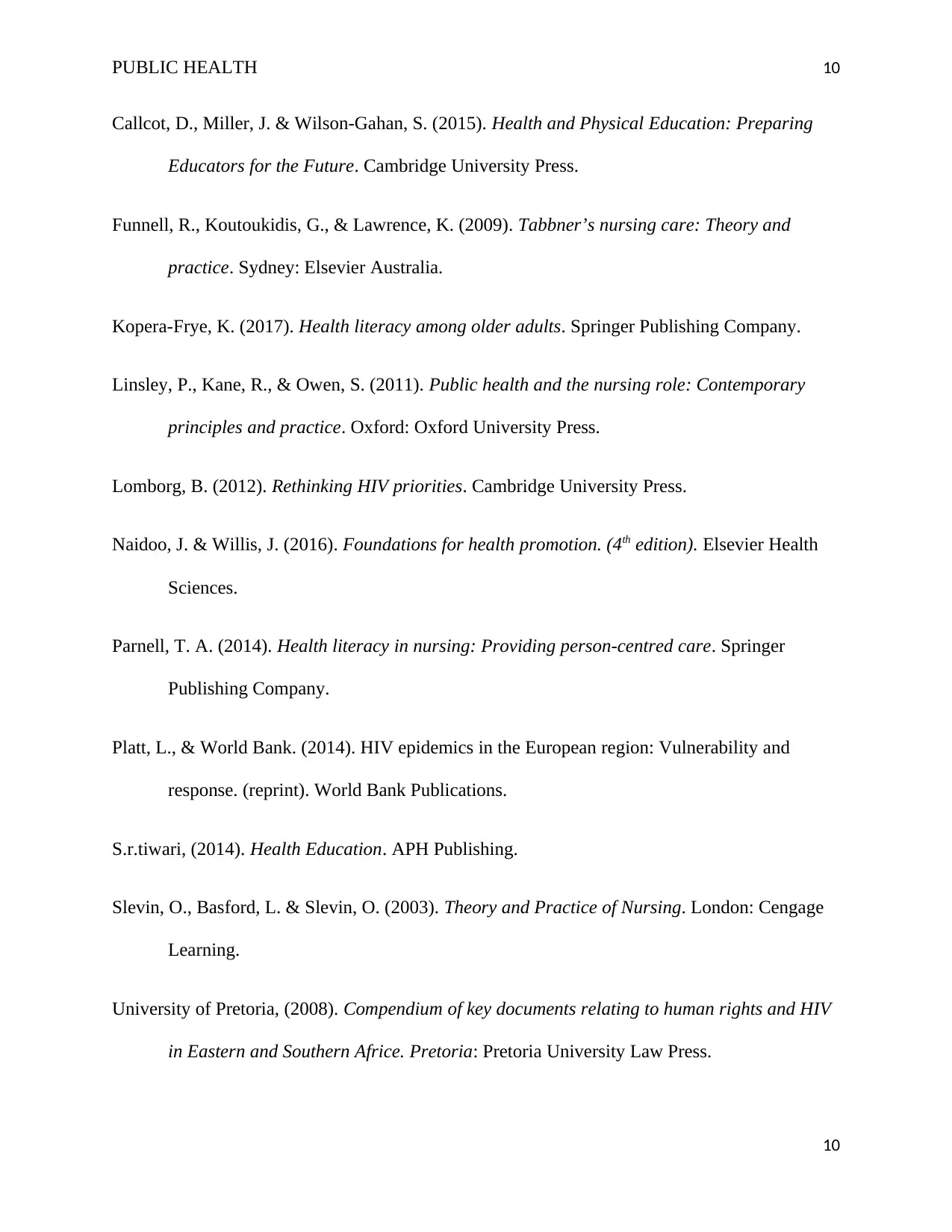
PUBLIC HEALTH 10
Callcot, D., Miller, J. & Wilson-Gahan, S. (2015). Health and Physical Education: Preparing
Educators for the Future. Cambridge University Press.
Funnell, R., Koutoukidis, G., & Lawrence, K. (2009). Tabbner’s nursing care: Theory and
practice. Sydney: Elsevier Australia.
Kopera-Frye, K. (2017). Health literacy among older adults. Springer Publishing Company.
Linsley, P., Kane, R., & Owen, S. (2011). Public health and the nursing role: Contemporary
principles and practice. Oxford: Oxford University Press.
Lomborg, B. (2012). Rethinking HIV priorities. Cambridge University Press.
Naidoo, J. & Willis, J. (2016). Foundations for health promotion. (4th edition). Elsevier Health
Sciences.
Parnell, T. A. (2014). Health literacy in nursing: Providing person-centred care. Springer
Publishing Company.
Platt, L., & World Bank. (2014). HIV epidemics in the European region: Vulnerability and
response. (reprint). World Bank Publications.
S.r.tiwari, (2014). Health Education. APH Publishing.
Slevin, O., Basford, L. & Slevin, O. (2003). Theory and Practice of Nursing. London: Cengage
Learning.
University of Pretoria, (2008). Compendium of key documents relating to human rights and HIV
in Eastern and Southern Africe. Pretoria: Pretoria University Law Press.
10
Callcot, D., Miller, J. & Wilson-Gahan, S. (2015). Health and Physical Education: Preparing
Educators for the Future. Cambridge University Press.
Funnell, R., Koutoukidis, G., & Lawrence, K. (2009). Tabbner’s nursing care: Theory and
practice. Sydney: Elsevier Australia.
Kopera-Frye, K. (2017). Health literacy among older adults. Springer Publishing Company.
Linsley, P., Kane, R., & Owen, S. (2011). Public health and the nursing role: Contemporary
principles and practice. Oxford: Oxford University Press.
Lomborg, B. (2012). Rethinking HIV priorities. Cambridge University Press.
Naidoo, J. & Willis, J. (2016). Foundations for health promotion. (4th edition). Elsevier Health
Sciences.
Parnell, T. A. (2014). Health literacy in nursing: Providing person-centred care. Springer
Publishing Company.
Platt, L., & World Bank. (2014). HIV epidemics in the European region: Vulnerability and
response. (reprint). World Bank Publications.
S.r.tiwari, (2014). Health Education. APH Publishing.
Slevin, O., Basford, L. & Slevin, O. (2003). Theory and Practice of Nursing. London: Cengage
Learning.
University of Pretoria, (2008). Compendium of key documents relating to human rights and HIV
in Eastern and Southern Africe. Pretoria: Pretoria University Law Press.
10
1 out of 10
Related Documents
Your All-in-One AI-Powered Toolkit for Academic Success.
+13062052269
info@desklib.com
Available 24*7 on WhatsApp / Email
![[object Object]](/_next/static/media/star-bottom.7253800d.svg)
Unlock your academic potential
© 2024 | Zucol Services PVT LTD | All rights reserved.





